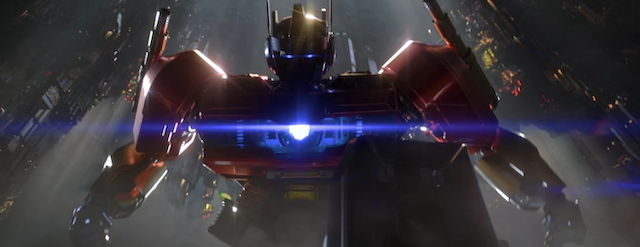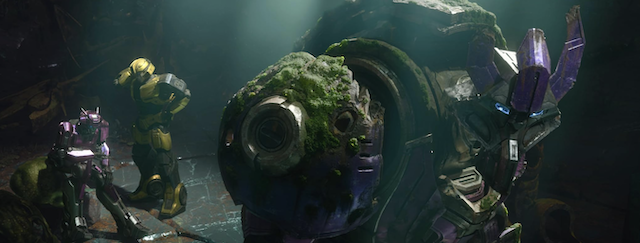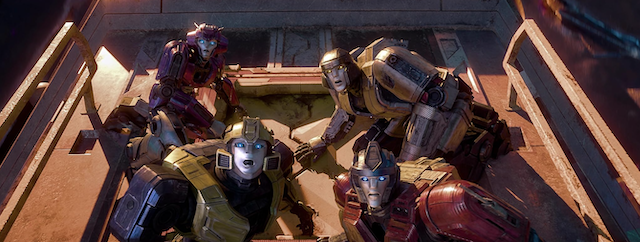

Q : First, I have to ask you where you grew up? I believe your father is Japanese, right?
Ramsey Naito: Yes, my father is Japanese, my mother is from New Orleans. I grew up in New York and Baltimore. I’m very close with my father. I went to Japan for summers, starting when I was 10, so I was very close to my Japanese culture.
Q: You seem like you’re growing up in a household that appreciates artists and artworks. How did you get into the film business? I believe you started as a production assistant to work your way up. Could you talk about that?
Ramsey Naito: Sure, my father is a sculptor, my mother is a painter, so I grew up in an artistic home. I went to art school my entire life. I went to Baltimore School for the Arts. I graduated from Maryland Institute College of Art. And then I went to CalArts. I was making sound sculpture and kinetic paintings on glass. And I met animators for the first time, while I had grown up in and gone to Japan and was introduced to anime and loved anime Galaxy 999, Doraemon and I loved Japanese anime.
I never thought I’d work in animation. I never thought I’d work in the industry, but when I went to CalArts, I met animators, we were all graduating, they were getting jobs, and they were like, Hey, apply for this job as a production assistant on a TV show called “Duckman.” And I got the job and that was the beginning and from there, I fell in love with animation.
I had no idea there was an office job with anywhere from 50 to 400 artists, obviously working commercially to execute one thing, but also so rich in their own practice as an artist. So it was just a great work environment for someone like me that I could go to an office and work with artists. And from there I worked on the Rugrats movie, Nickelodeon shows, I came in through the art side, and story side. I worked on the South Park movie, SpongeBob, Jimmy Neutron, Charlotte’s Web, and moved up to be who I am today.
Q : You mentioned you work in Nickelodeon Animation as a president, Cartoon Network, Blue Sky Studio. What are the essences that you learn from working at those companies that you can apply into the Paramount Animation.
Ramsey Naito: I think I would flip it. I think the one thing I learned about myself and my strengths at having an artist’s background is that I was able to really identify with the artist’s way and the artist’s practice in making an animated TV show or film. In the storytelling and how the storytelling informs the design and really how in production on a film, you may be making an animated film for three to six years.
It’s a highly iterative process where you are executing your movie off of a script page or through a story idea and you are evolving it during the process of making. And it is a collaborative process and one that needs a lot of focus, a lot of support, you need a safe space.
I was able to identify with this practice, help promote and create a safe place. For the director to maintain and evolve their vision. I have my strengths is being able to manage the creative side, but also succinctly align it with we’re staying on budget and schedule because with every movie, you do have no, I’ve never worked on a movie where you have endless funds to do whatever you want. You have to make a movie within a certain time frame, and that requires managing the creative process.

Photo by Courtesy of Paramount Pictures – © 2024 Paramount Animation
Q : Okay, there’s so many animation studios and productions such as like a Disney, Pixar, Sony Animation, LAIKA, and GKIDS, each company has like a specific approach, unique approach such as stop motion animation or animation that they distribute from other country and so on. What do you think is the selling point for Paramount animation?
Ramsey Naito: What I love about Paramount Animation is that we don’t have a house style. All of our movies are radically different and we four wall our productions around directors and their key leadership team, while we’re producing the front end here, mostly on the Paramount lot, we are in partnership with animation studios across.
But they’re all different, so we worked with ILM on Transformers. We worked with Mikros Animation on Teenage Mutant Ninja Turtles. Every production has a different animation studio and we partner with these animation studios based on their creative excellence, their fit.
And so our approach is that we are leading with creativity. We are four walling around directors and their key leadership and vision, and each movie is radically different. All shapes and sizes, while we may have a very expensive film in production, we also may have one that’s in production, for 12 million, 15 million. So our range of productions and how we can scale. It’s quite vast and it makes things very exciting. It’s not cookie cutter.
Q : Let’s talk about the Transformers One. As for our audience, we’ve been seeing the Transformers movie series. I’m curious to know how you and your team came up with an idea to tackle the main character Orion Pax, who is a younger version of Optimus Prime, the central character of the story.
Ramsey Naito:Well, Lorenzo di Bonaventura, the producer of all the Transformers movies, has been working on Transformers for, I think, maybe two decades. And over the course of making these movies, there’s always been a desire to make an origin story and have it take place on Cybertron, the home planet.
It’s always been spoken about, but no one ever has really seen it in its full glory. And so I think that the origin story was always in their back pocket to make. The stars aligned to make it now. We’re so lucky to have Josh Cooley as the director who just delivered a film that is spectacular and bold.
Cybertron is made of metal and it’s just a world that is immersive and really transports you into an environment you can feel and you can smell and the lights. The Color it’s just incredible, the emotional core of this story, I think, is very important, you’ve had all of these live action movies where you’ve seen these revered, iconic characters, Optimus Prime and Megatron, and they hate each other, this movie, the origin of their hate, embraces this fine line between love and hate, tells the story of their friendship, and what made them enemies, it lands so incredibly and it’s so relatable that I think that when audiences then go back and see the live action movies after seeing this one, their experience will be different. It will be informed by this origin story.
Q: Director Josh Cooley is really conscious about the colors and reflection of each character. I’ve noticed when a character feels emotional, they blink their eyes. Could you talk about the fascination about Josh’s direction and how he actually maps out these things all together.
Ramsey Naito: I think that one example, I give you an example. Josh was extremely focused on how this story would inform the design of our characters along their journey. So when we first meet Optimus Prime or Orion Pax and D 16, They’re miners. They’re given a number. They can’t transform.
And they’re small, but they have heart. They have dreams. They have hope. At least we see that in Orion Pax. And then when given their cogs by Alpha Trion, they transform, it’s an incredible moment. They become bigger, they become more powerful, but they don’t know how to use themselves yet.
They’re like, what? What is this great power, in the end, there is another design choice. They become Megatron and Optimus Prime. In the movie, at the end of this movie, we deliver these remarkable characters into being the characters we know today, hero and villain. They grow, literally grow into being their magnificent larger than life self. It’s a great example because it’s the story and the design in a way that was so meticulous and so inspired by creativity and allowed these characters to go somewhere and become themselves.

Photo by Courtesy of Paramount Pictures – © 2024 Paramount Animation
Q: I was really impressed by the casting of Chris Hemsworth, Brian Tyree Henry, Scarlett Johansson, Keegan-Michael Key, and Jon Hamm, talk about the casting process and having them not only to have their recognizable voices but also playing them as a character.
Ramsey Naito: I love the casting process on an animated film. We start with pulling voices from other films and putting them behind a static image. Or if we’re lucky, an animated version of the character they’re meant to play. And I remember looking at Hemsworth and Brian Tyree Henryjust knowing it was just magical. This was it, right? And so we did listen to the quality of their voices to make sure that they didn’t sound alike, that these actors who have such an incredible, high level of craft to their voice, We’re able to deliver it on screen, but in a dynamic to one another.
The voice cast, I’m so proud of the voice cast on Transformers One. This film was made during COVID. So we weren’t able to get the voice cast in the same booth, which is usually something we try to do. But they’re such professionals and were able to play off of one another on their own in a way that was seamless. And you really feel their craft on screen. You really feel their journey, the stories and that they’re telling because they’re just such incredible actors. Chris Hemsworth and Brian Tyree Henry, their voices are very recognizable, too.
In a way that adds value to the story in a magnificent way. Also Scarlett Johansson. I have to say I love Scarlett’s performance. She has some of the funniest lines in the movie. And she’s so tough. Literally inspires me in the film and because of her, I definitely bought a couple pink t-shirts, too.
Q : They told me to wrap it up, but I want to ask one more question. Your husband is Alex Winter, he did “Bill & Ted” movie series, and he directed Youtube Effect. What are the things that keep you guys motivated by working in this industry and to become more creative in a sense.
Ramsey Naito: Alex and I both work in the industry. I work in animation, he doesn’t, so our roles are very different and our mediums are very different, but we support each other that makes me feel empowered and inspired by what I do every day. I feel very lucky to be married to a director who can help me understand the challenge, help me understand the challenges of what we do, which is tell the very best stories, it’s one of the hardest jobs in the world to be able to tell a story that appeals to everyone that people love with characters that people love when that happens, it builds culture, it builds memories, builds nostalgia.
People learn from these animated films. You’re telling stories to kids. around themes, around acceptance and inclusion. You’re telling stories that hopefully make them learn about the world so they can grow up and be the best version of themselves too. With Alex and I, we’re parents, and we have three boys.
His support in telling stories that appeal to people like us, and appeal to kids like our kids is very helpful.
If you like the interview, share your thoughts below!
Check out more of Nobuhiro’s articles.
Here’s the trailer of the film.

